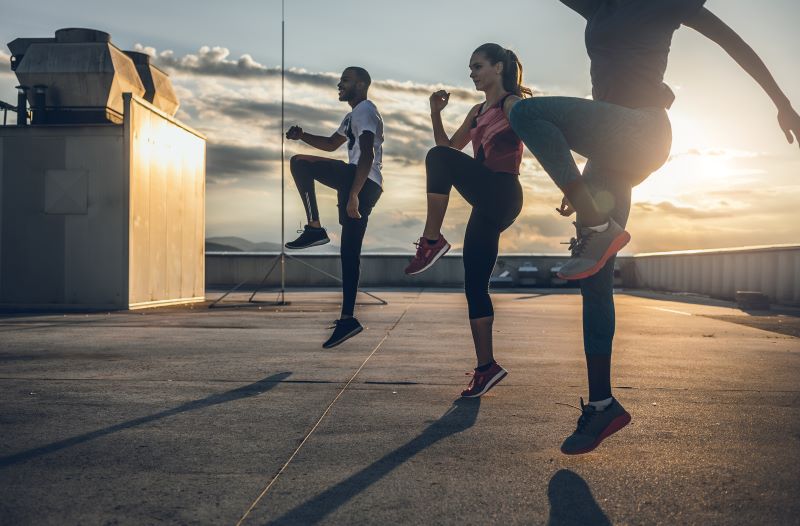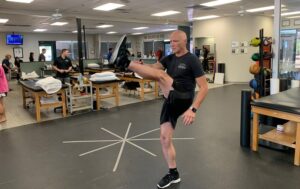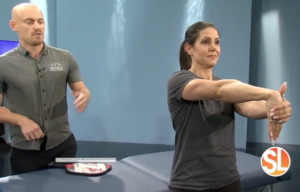Dynamic vs. static stretching are two common methods of warming up and improving flexibility, but they serve different purposes and are best suited for different situations. Understanding the proper type of stretching before and after activity is essential to enhancing performance and avoiding injury. When young athletes engage in physical activity, they are often encouraged by coaches and parents to stretch prior to activity. The goal is to prepare muscles for sports and decrease the risk of injury.
Preparing the Body for Physical Activity
A thorough warm-up period is designed to prepare the body for physical activity by:
- Increasing core body temperature
- Stimulating blood flow to the arms and legs
- Enhancing coordinated movement
- Improving range of motion
- Developing body awareness of joint position sense and movement
- Using movement to expand muscle and tendon flexibility
Dynamic Stretching:
- Purpose: Dynamic stretching involves moving your muscles and joints through a range of motion to increase blood flow, warm up your body, and prepare your muscles and joints for physical activity. It is typically used as part of a warm-up routine before sports or vigorous exercise.
- Technique: Dynamic stretches are performed by actively moving your limbs and muscles without holding a static position. These stretches mimic the movements you will perform during your activity. Examples include leg swings, arm circles, walking lunges, high knees, and butt kicks.
- Benefits:
- Increases blood flow and heart rate.
- Improves joint mobility and flexibility.
- Enhances neuromuscular coordination.
- Prepares your body for more intense activity.
- Reduces the risk of injury by increasing muscle elasticity.
Static Stretching:
- Purpose: Static stretching is used to improve overall flexibility and elongate muscles. It involves holding a stretched position for a prolonged period, typically 15-30 seconds or longer, without any bouncing or dynamic movement. It’s often used for post-exercise cooldown or as part of a general flexibility routine.
- Technique: In static stretching, you stretch a specific muscle or muscle group to the point of mild discomfort and hold the position without movement. Common static stretches include touching your toes while seated, calf stretches against a wall, or a standing quad stretch.
- Benefits:
- Increases flexibility and range of motion.
- Helps with muscle relaxation and stress reduction.
- It can alleviate muscle soreness and tension.
- Promotes better posture and body awareness.
- Best suited for cooldown or post-exercise recovery.
Designing Dynamic Stretching Programs:
- Move continuously, typically in laps for 10-15 minutes overall
- Vary the program according to the level of the athlete
- Start slow and progress to quicker and more advanced movements
- Avoid movements that are too intense and fatigue the muscles.
- Incorporate the whole body and imitate movements used in specific sports
Designing Static Stretching Programs:
- Stay in one position per muscle group
- Hold the stretch for 20-30 seconds
- Repeat the stretch 2-3 times per muscle group
- Address all muscle groups used in the specific sport
When to Use Dynamic vs. Static Stretching
Dynamic Stretching: Use dynamic stretching as part of your warm-up routine before activities that require power, speed, or agility. It’s particularly useful for sports like basketball, soccer, or sprinting, where explosive movements are necessary. Dynamic stretching gets your muscles and joints ready for the demands of such activities.
Static Stretching: Reserve static stretching for after your workout or as a separate flexibility routine. It helps improve overall flexibility and can be useful for activities like yoga or Pilates. Static stretching can also be beneficial for relaxation and stress reduction.
Remember that stretching should be done safely and should not cause pain or discomfort. It’s essential to warm up your body before attempting static stretches to prevent injury. Incorporating both dynamic and static stretching into your fitness routine can help you maintain optimal flexibility and reduce the risk of injury during physical activities.
For help designing a stretching program, contact a Foothills Sports Medicine Clinic near you and schedule an appointment.






